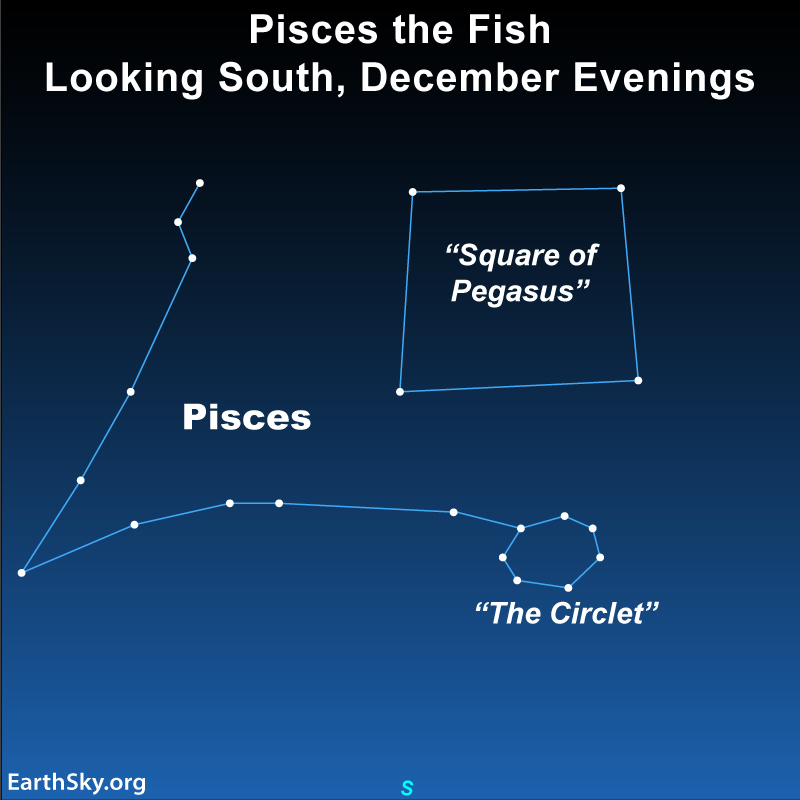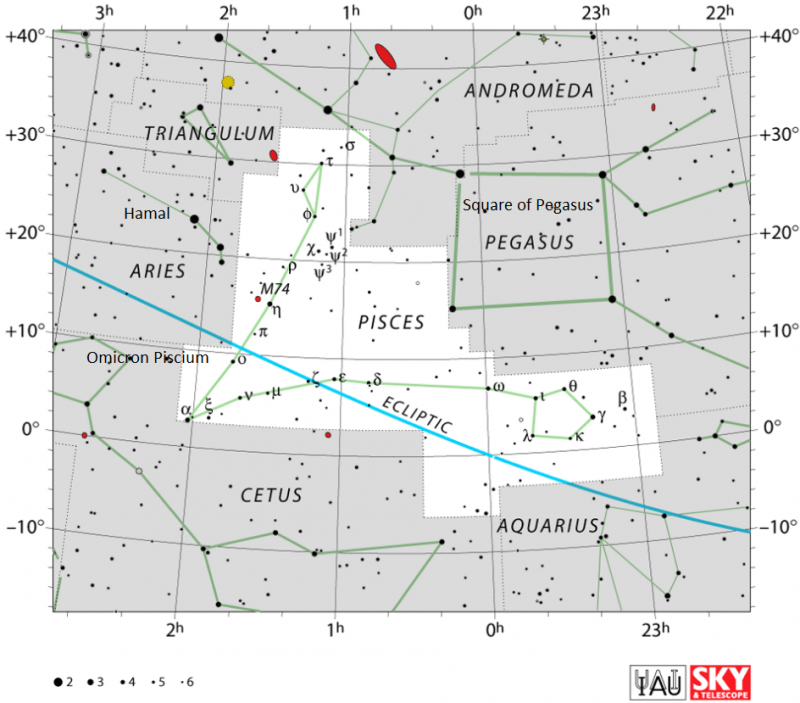
Pisces the Fish is one of the constellations of the zodiac, which means that it lies on the ecliptic, or path of the sun and planets through our sky. Currently, Jupiter lies within the constellation’s borders and will remain there until mid-May 2023.
Pisces has the nickname of first constellation of the zodiac, because the sun appears in front of this constellation during the March equinox. With this in mind, one tropical year is usually defined as the period of time between successive March equinoxes. So – in this sense – the March equinox marks the beginning of a new year. Also, that is why Pisces often appears as marking the starting point of the zodiac.
Generally, the best time to view constellations in the night sky is when they’re opposite the sun in the sky. They rise at sunset and are up all night. So, if the sun is in Pisces in March, then the opposite side of the calendar, October and the following months, is a good time for observing Pisces. Indeed, in December, by the time the sky is dark, Pisces is already high in the southern sky for us in the Northern Hemisphere. Pisces is at its highest for the evening at about 8 p.m. local time in December.
How to find Pisces
Indeed, you need a dark country sky to see this fairly dim constellation swimming in what the early stargazers considered to be a watery region of the lore-laden heavens. Pisces is northeast of the constellation Aquarius the Water Bearer and to the northwest of the constellation Cetus the Whale.
Fortunately, you can find Pisces rather handily by referring to the signpost known as the Great Square of Pegasus. Look first for the Circlet of Pisces – otherwise known as the head of the Western Fish – to the south of the Square of Pegasus. Once you’ve found the Western Fish, go on from there to catch the Eastern Fish that’s jumping upward to the east of the Square of Pegasus. As seen from the northern tropics or the Southern Hemisphere, the Eastern Fish appears to be plunging downward. The entire constellation looks like the letter V, and a very graceful and lovely V at that.
The stars of the Fish
Pisces has few bright stars. The stars most people focus on are the ones that create the Circlet of Pisces. The brightest star here is the 3.7-magnitude Gamma Piscium. Moving counterclockwise around the circle, we next find Theta Piscium at magnitude 4.2. Then comes Iota Piscium at magnitude 4.1. Lastly is Lambda Piscium at magnitude 4.5. These stars are too dim to see from a light-polluted city.
Marking the bottom of the V-shape where the tails of the fish come together is a magnitude-3.8 star named Alrisha, or Alpha Piscium. Fourteen degrees northwest is magnitude 3.6 Eta Piscium, the constellation’s brightest star. (Halfway in between is magnitude 4.2 Omicron Piscium.) Just over one degree east from Eta Piscium is the one Messier object in Pisces.

The lone Messier object
Pisces can only claim one Messier object – that is, a fuzzy object resembling a comet but really a star cluster, nebula or galaxy – within its borders. It’s Messier 74 (M74), a face-on spiral galaxy looming at an estimated 35 million light-years distant.
In the month of March, when it’s technically possible to see all the Messier objects in the span of one night during a Messier marathon, this Messier object in the constellation Pisces is one that is commonly missed.
That’s because, at that time of year, M74 lurks rather low in the western sky at nightfall and quickly sinks out of view shortly thereafter. Plus, this distant galaxy has an extremely low surface brightness, so excellent seeing conditions are absolutely critical for catching it. You don’t need a large telescope as much as you need a dark, transparent sky.
Try spotting it this December using averted vision on a dark, clear moonless night.

Pisces in mythology and star lore
Greek and Roman versions of Pisces’ sky lore seemed to have come from Syria, where fish were regarded as divine. There seems to be some confusion as to whether the ancient Syrians abstained from fish altogether or only fish from the Chalos River (presently called the Queiq or Aleppo River).
The Syrian goddess of love and fertility, Atagartis, is often portrayed as half woman and half fish. She is thought to be the origin of the Greek goddess Aphrodite and the Roman goddess Venus.
According to Greek mythology, the fire-breathing monster Typhon was about to devour Aphrodite (the Roman Venus) and her son Eros (the Roman Cupid), so they turned into fish and jumped into the Euphrates River to make a great escape. Mother and son tied themselves together with a cord to make sure they would not lose one another in the tumbling waters.
How long is the Age of Pisces?
By some definitions, we’ll continue to live within the Age of Pisces as long the sun shines in front of this constellation on the March equinox. By the way, although the sun hasn’t appeared in front of the constellation Aries on the equinox for over 2,000 years, we still refer to the March equinox point as the First Point in Aries.
If we accept the constellation boundaries as defined by the International Astronomical Union, the Age of Pisces started in 68 BCE and the Age of Aquarius will begin in 2597.
But there are many varied views on this, some of which you can read about in this post: When does the Age of Aquarius begin?
Bottom line: Pisces the Fish is a zodiac constellation that is high in the sky on December evenings. Look for it and its asterism, the Circlet of Pisces.
Meet Taurus the Bull in the evening sky
Meet Gemini the Twins, home to 2 bright stars
Leo the Lion and its backward question mark
Virgo the Maiden in northern spring skies
Meet Cancer the Crab and its Beehive Cluster
Meet Libra the Scales, a zodiacal constellation
Scorpius the Scorpion is a summertime delight
Sagittarius the Archer and its famous Teapot
Capricornus the Sea-goat has an arrowhead shape
Meet Aquarius the Water Bearer and its stars
Meet Pisces the Fish, 1st constellation of the zodiac
Say hello to Aries the Ram
Born under the sign of Ophiuchus?











